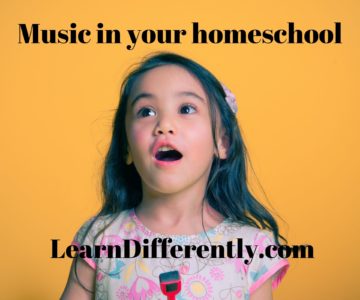Music in your homeschool

by Kathy Kuhl
Make time for music? If you’re homeschooling a child with learning challenges, you may think you’ve got more urgent business.
Maybe not.

Music opens minds
Music can stir hearts, inspire, and open minds—and mouths.
This nine-year-old boy’s awestruck reaction to hearing Mozart last week got me thinking. Ronan Mattin has autism and is mostly nonverbal. But a concert he attended earlier gave him plenty to talk about for weeks. This month, his grandfather brought him back to Boston.

Perhaps you heard the story. As the piece ended, in the three seconds of appreciative silence before the applause, this boy with autism loudly said, “Wow.”
Kind-spirited laughter and applause showed the audience agreed with the boy. Radio station WBGH, which recorded the event, tweeted this clip with the comment, “Mozart makes us feel that way, too!”
The performance touched this boy’s heart so deeply that he expressed it—appropriately. (I’m sure his family is glad he waited until the right time!) His grandfather, Stephen Mattin, reported, “I can count on one hand the number of times that [he’s] spontaneously ever come out with some expression of how he’s feeling,” according to the WGBH website. (Links below in resource section.)
Don’t have time for another subject?
When you’re trying to get your child to read, or sit still, or learn math facts, or algebra, you may not appreciate my suggesting more work. But introducing your child to great music can help them in deeper ways than other instruction does.
- There are well-documented connections between music and higher level thinking. While listening to Mozart doesn’t actually make you smarter, music gives other cognitive benefits. Psychology Today reported that “there IS evidence that learning music and being involved in music helps improve a child’s math and language abilities.” (Link below.)
- You may discover undeveloped musical tastes or talents.
A friend’s daughter with ADHD is a rising young composer. Symphony orchestras across the U.S. have commissioned and performed her works. What if her parents hadn’t given her opportunities and supported her interest? - Music is fun! You can launch a lifelong interest, with multi-generational connections. Note that a grandfather took Ronan Mattin to the concerts. Don’t have a concert-going grandfather? Do you have a neighbor who plays banjo, accordion, electric bass, drums? Can you visit?
One of the parents I interviewed for Homeschooling Your Struggling Learner found that her son worked better at homeschool if he practiced drums first. (It’s a great upper body workout, too.) - By homeschooling, you can enrich your child’s life with all kinds of music. Your favorites may leave them cold, so expose them to good music in many genres: classical, opera* (see outrageous link below), jazz, gospel, modern, bluegrass. Just because the public schools think they can’t afford to continue the arts in schools doesn’t mean we cannot. It doesn’t take money to introduce them to great works.
Begin with the little ones, simply
Once, I asked Dr. Carol Reynolds, aka Professor Carol, how to help my daughter with their firstborn. Since age two, this granddaughter has loved music. So I asked my friend Carol what more we could do to nurture this love.
If you don’t know Carol, you’re missing out. She’s one of the most dynamic, fun, passionate speakers I know. A musicologist, she loves music, the arts, and history—and makes it easy for us to, as well. Sign up for her newsletter and check out her wonderful video courses and resources at the link at the end of this post.
To help your little one enjoy music, keep it simple, keep it live, keep it fun. There’s so much more to this than putting on music as you drive.
-
- Let your children experiment with timbre—the different kinds of sounds we hear from striking different objects. Every toddler knows how to hit things. (Of course, we guide and limit it.) But let them experience the difference between tapping on a book, a table, a window, a door, a swing set. Have fun!
- Let them play with pitch, too. Try saying the same word at different pitches. Sing words to them at different pitches.
Water Music: Show your kids how to blow over the mouth of a water bottle when it’s mostly full. Then drink a bit, blow again, and hear the pitch change. Once it’s safe to let them, fill glasses with water at different levels and let them tap them. - Sing! It doesn’t matter if you cannot carry a tune. Instead of talking or calling, Carol says sing,
“Time to come to supper!”
“Would you pass the salt, please?”
“Eat three more bites of that if you want dessert!”(If you can’t imagine how to sing these, use the tune of any old children’s song that fits, or any favorite tune. Anything can be sung.)
Don’t Push
Play with sound. That’s the main thing. Let them enjoy it.
Don’t push them. Recently, I saw a man showing his three-year-old his guitar. She wanted to strum, to hear and feel the loud vibrations. He wanted to show her how his fingering different chords changed her tones. But she was three and just wanted to strum open strings.
I would say, let her strum. I set limits, because I don’t want kids damaging my guitar, battering a piano keyboard, or breaking my crystal. But first let them enjoy creating and hearing sound—stopping before it drives anyone crazy, of course. Don’t push the music lesson too fast.
Later I heard Carol Reynolds give a workshop on teaching little ones to love the good, true and beautiful. Does that sound hard for kids with learning challenges? Actually, it’s easy, and better yet, fun.
Not a spectator sport
Hands-on music is best and not just for tots. Music should not be only a spectator sport. Look at the decline over the generations:
My mother’s friends bought sheet music, played popular songs on the piano, and sang together.
My generation brought their guitars and sang. But we also started carrying radios and listening to them, making less of our own music. After all, the pros sounded really good, right?
Then we began to lose the shared experience of music when the Walkman and iPod let us listen alone. Though I love being able to listen when I walk or run (it makes a treadmill endurable for me), there is a danger. I lose the shared experience of music. Shared experiences foster the social engagement our children need to learn. (What if Mr. Mattin had only bought Ronan a recording?)
So let your kids play with music and sound.
Five more easy ways to build music into your homeschool
Supplement that play with these five introductions to great music, which combine words and music Enjoy these with your children:
-
- Peter and the Wolf, by Serei Prokofiev, combines orchestral music with a narrator. As each character enters, we hear his musical theme and learn which instrument plays the theme. (To this day when I hear oboes and clarinets, I sometimes think of the duck and the cat.)
- Carolyn Sloan’s Welcome to the Symphony, illustrated by James Williamson, takes on the famous Beethoven’s Fifth Symphony. Buttons on the side of the book, play themes and introduce different instruments.
- Or, for a mock-sinister approach, try Lemony Snicket’s The Composer Is Dead.
- Before taking a younger child to a first live concert, you can build the anticipation by reading The Philharmonic Gets Dressed, by Karla Kuskin, illustrated by Marc Simont.
- Ready for the next step? Carol Reynolds recommends the SQUILT music curriculum for younger children.
For slightly older children
For perhaps age 9 and up:
-
- Leonard Bernstein and the New York Philharmonic’s Young People’s Concerts series are available on YouTube. The sample below, “Listening to The Planets by Gustav Holst” will show that John Williams was probably listening to Holst (and Bruckner) before he wrote the Star Wars music.
- Benjamin Britten’s Young Person’s Guide to the Orchestra, like Peter and the Wolf, combines orchestra with narration, but without a story. The music by Purcell is dramatic in itself. The narrator introduces the four sections of the orchestra explicitly, then illustrates the differences among the instruments of each section, e.g. flutes v. piccolos. Your children may enjoy the British accent of this narrator in the link below.
- Want to go in more depth conveniently with an expert who is also a fun, engaging teacher? Professor Carol produces excellent music curricula.
A Musical Question
How to you incorporate music in your homeschool? Please comment below. Thanks.
Resources
- WGBH reported on the boy who cried “wow.”
- https://www.psychologytoday.com/us/blog/your-musical-self/201005/the-mozart-effect-doesnt-work
- Professor Carol’s blog on “Children’s Natural Love for Opera.”
- Professor Carol’s website offers excellent video curricula, insights, and other great resources. Sign up for her newsletter and try a class for free. See “Free Associate Membership” and sample them all.
- A sample of Bernstein’s Young People’s Concerts. Holst’s “The Planets” is a good choice for anyone who thinks classical music is boring.
https://www.youtube.com/watch?v=XuMSopdrWSQ

